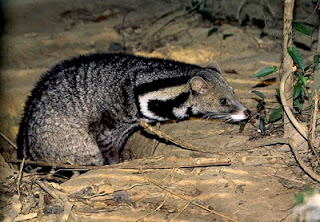The Asian Palm Civet (
Paradoxurus hermaphroditus) is a viverrid found in tropical forests throughout
Asia, though they are mostly concentrated in the South and South East
areas. They have a rather interesting look to them, almost like a cat
crossed with a weasel. They have body lengths of up to 21in (53cm) with a
tail of about the same length. They weigh 4-10lbs (2-5kg). Asian Palm Civets are also known as
Toddy Cats and Common Palm Civets.
Asian Palm Civets are
nocturnal and terrestrial. They come out at night
to feed without as much risk from predation, and their diet consists of small mammals and insects, as well
as fruits and other native vegetation. They are solitary animals, and
really only come together during the brief breeding season. Liters range
from 2-5 young.
One interesting fact about the Asian Palm Civet is that they eat whole
coffee beans. These beans pass through their digestive system whole and
are then harvested from their feces by humans. This coffee, known as
Kopi Luwak, is the most expensive coffee in the world, and sells for
upwards of $200 per pound.
Asian Palm Civets are currently listed as being of Least Concern, though
habitat loss could affect their population in the future.

Comments
Post a Comment